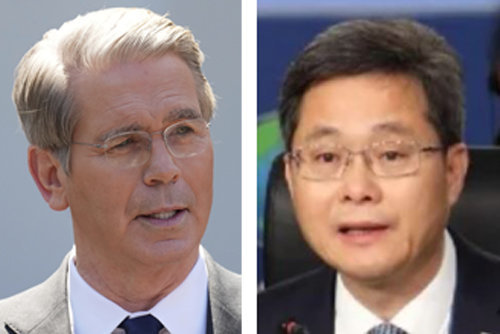Geneva tariff deal signals U.S.-China shift amid trade war
Geneva tariff deal signals U.S.-China shift amid trade war
Posted May. 14, 2025 07:35,
Updated May. 14, 2025 07:35

The Financial Times reported on May 12 that the United States and China held a secret meeting in Washington about three weeks ago, prior to their agreement in Geneva to reduce tariffs on each other’s goods by 115 percentage points for 90 days. According to the report, U.S. Treasury Secretary Scott Bessent and Chinese Finance Minister Lan Fo’an met in the basement of the International Monetary Fund (IMF) headquarters, where they reached a consensus that significantly influenced the breakthrough in Geneva.
Bessent and Lan both attended the G20 finance ministers’ meeting and the spring meetings of the International Monetary Fund and World Bank, held in Washington, D.C. from April 21 to 26. Their meeting—marking the first high-level in-person contact between the two countries since the start of the second Trump administration in January—is believed to have generated momentum for the Geneva tariff deal. Analysts say the two ministers agreed that prolonging the trade war would seriously damage both economies. Craig Singleton, a senior fellow at the Foundation for Defense of Democracies, told the Financial Times that the unexpectedly swift Geneva agreement suggests both countries are in more difficult economic positions than they publicly acknowledge.
However, experts warn that reaching a final comprehensive deal will be a challenging process. Scott Kennedy, a China expert at the Center for Strategic and International Studies (CSIS), said the global financial markets may find temporary relief in the Geneva agreement, but the crisis is far from over. He predicted the trade negotiations would proceed like “a roller coaster.”
Under the Geneva deal, the U.S. reduced its tariffs on Chinese goods from 145 percent to 30 percent, while China slashed its retaliatory tariffs on American products from 125 percent to 10 percent. Capital Economics, a financial analysis firm, projected that when other associated costs are factored in, the effective total tariffs would be around 40 percent for Chinese goods entering the U.S. and 25 percent for U.S. goods entering China.
Hyun-Seok Lim lhs@donga.com





![[단독]“男 군대가니 女도 가라는 식으로 여성징병제 문제 못풀어”](https://dimg.donga.com/c/138/175/90/1/wps/NEWS/IMAGE/2025/12/08/132907201.1.jpg)

